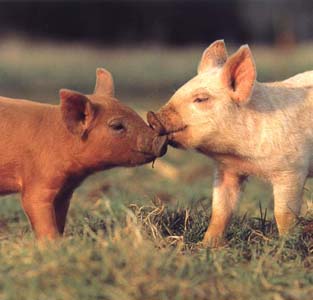
Module 2. Selecting
Pigs
Based on our years of experience,
and research findings, we find the following elements to be important
in selecting piglets for an organic pig farm.
Breed. Make
sure the pigs you choose come from a good breed. I am not a Nazi, but
I would say that pig breeds are very important when you choose a piglet,
which will grow into the future generation of organic pigs. Some pigs
are hybrids. And those industrial farmers would tell you that hybrids
are superior just as hybrid humans are smarter. To begin with, that
is not politically correct. I would think that you should choose a pure-breeded
pig to start your farm with. Although you suffer from a longer growth
cycle, you probably can get a better price for having a pure, organic
price. In Central New York, organic pig pork sells 120% higher than
pork produced on industrial pig farms.
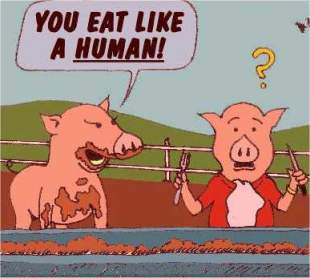
Table Manners.
We have known for years that a pig’s appetite correlates positively
to its weight. Therefore, if a pig eats a lot, it will grow very fast.
I hope this profound truth has given you insight into a pig’s
future.
Anyway, when you buy piglets
for your organic pig farming, please make sure you find a pig that eats
very well. It is highly desirable to visit the pig seller when he or
she is feeding the pigs. Or bring your own pig food to test it. You
can forget about those pigs who have good table manners. When you see
a pig that starts to grunt at the smell of any food, when you see a
pig that makes a lot of noise while eating, that means the pig enjoys
its food. That’s the one you should pick!
Tip: Some sellers starve
their pigs so that they can eat a lot when the buyers come. Do not be
fooled by such hooligans. We highly recommend you make surprise visits
to the sellers. Catch them when they are least prepared, just as the
Syracuse Police raids a bar that sells alcohol to college freshmen and
sophomores.
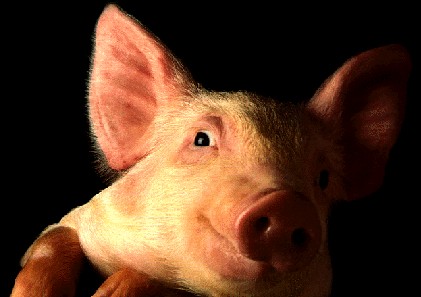
Looks. Does it matter at all? Of course it does. Good
looks will attract pigs of the other sex. In that sense at least, it
is important. Also, there are biological reasons to choose good-looking
pigs for your organic farms. Scientific findings have consistly shown
pigs with the following characteristics have a better chance of having
good health, fast growth and a happy life: A good piglet should have
a long body, or slim, like a human model. “It should have a broad
breast, short mouth. It should also have a robust bottom. In the mean
time, it is also desirable to find one with short but strong limbs.
Good bodily proportion is also very important.” (Li, 2004) If
some of these descriptions sound vague, imagine the combination of Jennifer
Lopez, Arnold Schwarzenager, and Billy Fuccilo.
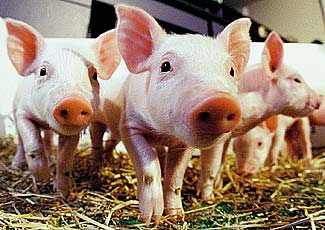
Health.
It is important that your piglets start healthy. If you buy a sick pig,
you’ll suffer a lot of financial losses. So, make sure all of
them are healthy. Call it head start, or no pig left behind. One way
you can tell whether a pig is healthy is to see whether it has a dirty
tail (from toilet). Chase the pig a little bit, let it run and see whether
it coughs. When you chase the pig, do not run too fast, otherwise you
will cough too.
Skin. Well, the color does not matter so much. Deep inside all pigs
are the same, no matter what kind of color it has. However, you should
check wether the pig has a shiny, smooth quality to its hairs. A clean
skin is also important. Do not buy piglets with a very bad hairstyle
even if they are very cheap.
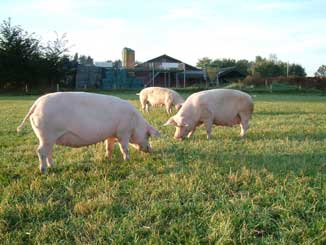
Mood. A
high-spirited pig is a better choice than a pig with a very low mood.
A high-spirited pig often wags its tail frequently. Its ears stand upright.
Once again, if such description sounds vague, think of some one who
is waiting for the results of a million-dollar jeapody. Sick pigs do
not wag their tails as often. Their tails are thin, long, and dangling
hehind them like a section of broken rope. I am sick even to think of
them. Avoid these pigs like plagues.
Review Question:
- Please develop a checklist
for selecting a good piglet for organic pig farming
Questions, concerns,
decisions, assertions, suggestions?
Reference:
Li, J. Z. (2004), “How to Selected Piglets”, Retrieved October
25, 2004 from http://www.gsny.com.cn/syjs/detail.php?CC_NO=394&key=
All images have been linked
to their sources

